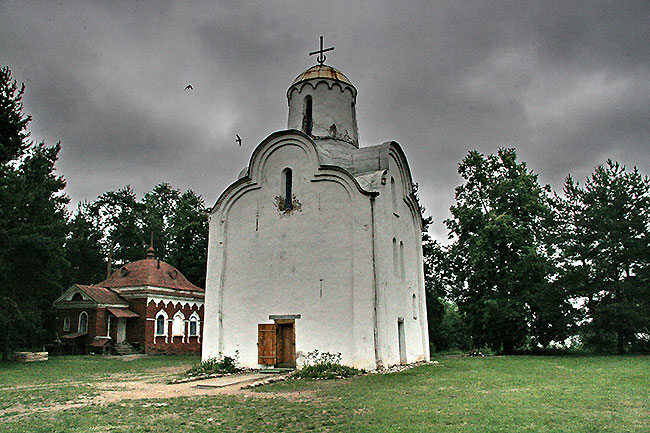The Church of the Nativity of Our Lady-at-Peryn
 On the site where the Volkhov River flows from Lake Ilmen is a small pine grove, called Peryn. Legend has it that in pre-Christian times there was in it a pagan sanctuary of Perun, the ancient Slavs' god of thunder and lightning. After the Novgorodians had been baptized, they destroyed the sanctuary, chopped down the wooden idol of Perun and threw it into the Volkhov. Excavations of 1951 have confirmed the fact that the sanctuary lay to the south-west of the Church of the Nativity of Our Lady and that it had the form of an eight-petal flower laid out in stone. Until quite recently art historians dated the Church of the Nativity to the 15th century. However, extensive postwar research has shown that the church was constructed in the first quarter of the 13th century. This was the last stone building in Novgorod to be erected prior to the Mongol-Tartar invasion. In many respects, it anticipated the style of Novgorodian architecture of the 16th and 17th centuries. One of the novel features is its roof, borne on a three-foil arch and conforming to the construction of the vaults. The decor is extremely frugal, as was usually the case with Novgorodian churches; merely a band of relief ornamentation enlivens the top of the drum. The single apse, made somewhat lower compared to the overall height, enhances the impression of the building's weightlessness and its surge skyward. On the site where the Volkhov River flows from Lake Ilmen is a small pine grove, called Peryn. Legend has it that in pre-Christian times there was in it a pagan sanctuary of Perun, the ancient Slavs' god of thunder and lightning. After the Novgorodians had been baptized, they destroyed the sanctuary, chopped down the wooden idol of Perun and threw it into the Volkhov. Excavations of 1951 have confirmed the fact that the sanctuary lay to the south-west of the Church of the Nativity of Our Lady and that it had the form of an eight-petal flower laid out in stone. Until quite recently art historians dated the Church of the Nativity to the 15th century. However, extensive postwar research has shown that the church was constructed in the first quarter of the 13th century. This was the last stone building in Novgorod to be erected prior to the Mongol-Tartar invasion. In many respects, it anticipated the style of Novgorodian architecture of the 16th and 17th centuries. One of the novel features is its roof, borne on a three-foil arch and conforming to the construction of the vaults. The decor is extremely frugal, as was usually the case with Novgorodian churches; merely a band of relief ornamentation enlivens the top of the drum. The single apse, made somewhat lower compared to the overall height, enhances the impression of the building's weightlessness and its surge skyward.
|